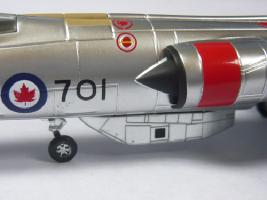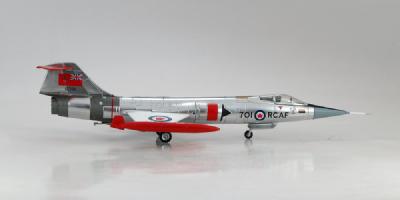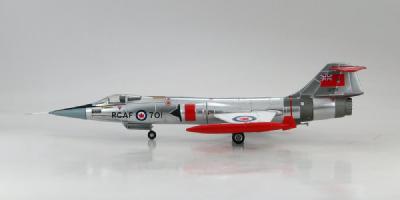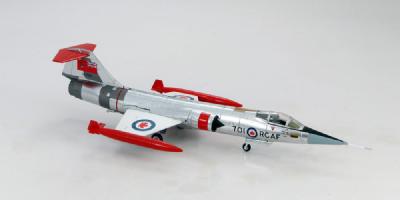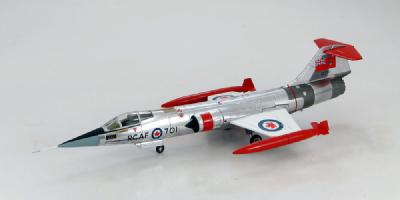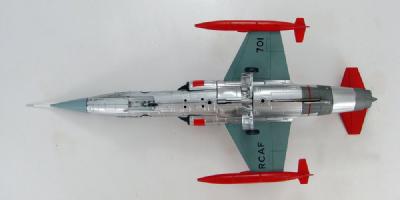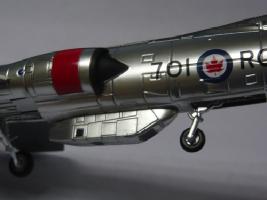Hobby Master Archive
Air Power Jets 1/72
F-104
RCAF CF-104 12701 special chrome finish LIMTED EDITION only 1000 pieces worldwide
Hobby Master 1/72 Air Power Series HA1011 RCAF CF-104, 12701 “special chromed finish “LIMITED EDITION”
Limited Edition of 1500 pieces worldwide. Die-cast metal. Superb detailing in 1/72 scale. Pre-painted in a special chrome finish Pilot figure Pad applied markings. Fully assembled. Display stand included. Option to display model with wheels up or down. Vicon pod Minimum use of plastic. Very collectable The RCAF received their first CF-104 in March 1962. Although originally designed as a supersonic interceptor the Canadian Air Force used it primarily for low level strike and reconnaissance. The Canadian version of the F-104 was capable of carrying a ventral mounted Vinten Vicon pod with 4 cameras inside for reconnaissance picture taking. On September 4, 1963 number 12900 was the 200th and final CF-104 produced and entered service on January 10, 1964. The CF-104 retired from service in 1985 when it was replaced by the CF-18 Hornet. Over the 25 years of active service 110 aircraft were lost to accidents earning it nicknames like “Widow Maker” and “Lawn Dart”. The RCAF CF-104 probably had the most flying time of any variant with an average of 6,000 hours per plane over their life time compared to the Luftwaffe’s 3,000 hours.
Looking for a supersonic replacement for the RCAF aging Sabre Mk. 6 the Canadian Government chose the Lockheed F-104. This never was the choice of the Air Force but it was a decision based more on economics and politics. It was decided that Canadair would build the Canadian version under contract. Originally designated CL-90 the aircraft finally became the CF-104. In the spring of 1961 the first Canadian-built CF-104 serial number 12701 was airlifted to Palmdale, California where on May 26, Lockheed Test Pilot Ed Brown performed its maiden flight. The Canadair number for this Aircraft was 683a- 1001, the RCAF serial number was 12701 but in July 1970 renumbered as 104701. In 1967 aircraft 12701 was one of 5 aircraft sent to the Central Experimental and Proving Establishment (CEPE) located at Cold Lake Alberta Canada. These aircraft were used for evaluations and flight trials of all the aircraft modifications, systems and armaments. Why this aircraft wasn’t preserved is unknown to me but in 1985, possibly after being cannibalized, it was struck off the inventory list and later scrapped.
Specifications for the CF-104 Manufacturer: Canadair Designation: originally a super sonic interceptor but adapted for low level strike and reconnaissance Crew: 1 X pilot - “D” variant 2 crew Dimensions Wingspan: 21’ 11” Length: 54’ 9" Height: 13’ 6" Wing area: 196.1 sq. ft Powerplant 1 X Orenda Engines J79-OEL-7, 10,000 lb. s.t. dry / 15,800 lb. s.t. with after burner Performance Maximum speed: Dash - 1,550 mph (mach 2.35) @ 40,000' 915 mph (mach 1.2) @ sea-level Climb to 30,000’ - 1.5 minutes Service ceiling: 50,000 ft (12,000 m) Range: 1,630 mi (1,420 nm, 2,630 km)
Weights Empty: 13,909 lbs. Clean: 21,005 lbs. Maximum take-off: 28,891 lbs External stores 5 hard points - 1 X under the fuselage, 1 X under each wing, 1 X at each wing tip Armament External bombs and missiles such as: napalm bomb, cluster bomb, BL755 cluster bomb, a 19 rocket rocket-pod, Mk. 82 bomb, MN1A practice bomb dispenser, an M61A1 Vulcan 20mm cannon added to later versions.
RED ENSIGN
THESE ARE PRE-PRODUCTION PICTURES NOT THE FINISHED MODEL.
| Added to archive | 2015-11-19 |
| Last modified | 2015-11-19 |
| Leaflet | 2008-06-01 June 2008 |
